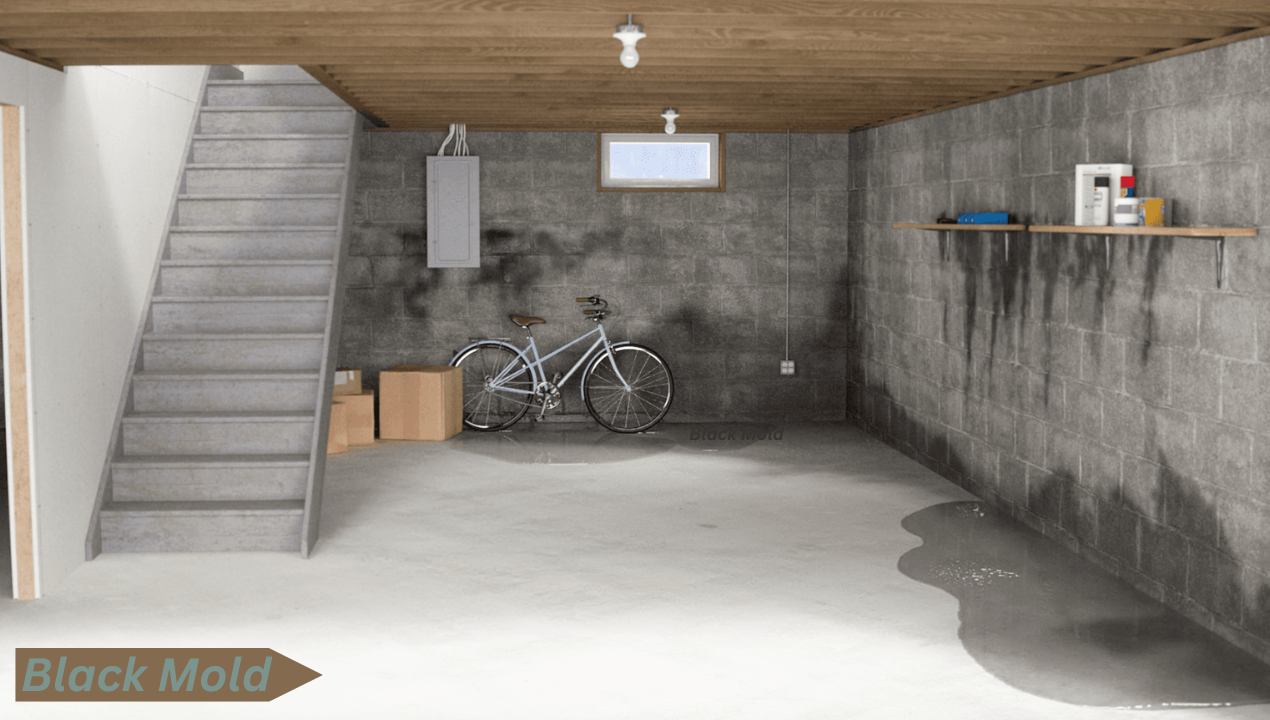Mold thrives in damp, dark environments, making concrete basement walls an ideal breeding ground. The porous nature of concrete absorbs moisture, providing a conducive environment for mold spores to flourish. Common signs of mold growth include musty odors, discoloration, and visible patches on the walls.
Causes of Mold Growth
- Moisture
Excess moisture is the primary catalyst for mold growth. Leaks, floods, or high humidity levels can result in water seepage into the basement, creating an environment ripe for mold colonization.
- Lack of Ventilation
Poor ventilation exacerbates moisture buildup, allowing humidity to accumulate and promoting mold growth. Inadequate airflow prevents damp areas from drying out, creating favorable conditions for mold proliferation.
- Organic Material
Organic matter, such as dust, dirt, or debris, serves as a food source for mold. When combined with moisture, organic material on concrete walls becomes a breeding ground for mold spores.
Safety Precautions Before Removal
Before mold removal, prioritize safety measures to minimize exposure to harmful mold spores.
- Protective Gear
Wear protective clothing, including gloves, goggles, and a respirator, to shield yourself from mold spores and cleaning chemicals.
- Ventilation
Ensure proper ventilation by opening windows and using fans to exhaust airborne mold spores outside.
- Containment
Contain the affected area using plastic sheeting to prevent mold spores from spreading to other parts of the house.
Tools and Materials Needed
Gather the necessary tools and cleaning solutions before starting the mold removal process.
- Cleaning Solutions
Choose an appropriate mold cleaner, such as bleach, vinegar, or commercial mold remover, to effectively eliminate mold from concrete surfaces.
- Scrubbing Tools
Use stiff-bristled brushes or scrubbing pads to dislodge mold from the porous surface of concrete walls.
- Protective Equipment
Equip yourself with protective gear, including gloves, goggles, and a respirator, to minimize exposure to mold spores and cleaning chemicals.
Step-by-Step Guide to Removing Mold
Follow these steps to effectively remove mold:
- Inspection
Thoroughly inspect the affected area to assess the extent of mold growth and identify any underlying moisture issues.
- Preparation
Prepare the workspace by laying down plastic sheeting to contain mold spores and protect surrounding surfaces from cleaning solutions.
- Cleaning
Apply the chosen mold cleaner to the affected areas and scrub vigorously to remove mold from the concrete surface.
- Drying
Allow the cleaned surfaces to dry completely to prevent mold regrowth. Use fans or dehumidifiers to expedite the drying process.
Preventive Measures to Avoid Future Mold Growth
Take proactive steps to prevent mold recurrence on concrete basement walls:
- Improve Ventilation
Increase airflow by installing vents or fans to reduce humidity levels and promote drying.
- Reduce Moisture
Address any sources of moisture, such as leaks or condensation, to prevent water accumulation in the basement.
- Seal the Concrete
Apply a waterproof sealant to concrete walls to prevent moisture absorption and inhibit mold growth.
When to Seek Professional Help
If mold infestation is extensive or if there are underlying structural issues, it’s advisable to seek professional assistance. Mold remediation experts have the expertise and equipment to effectively address severe mold problems.
Conclusion
Removing mold from concrete basement walls requires diligence, proper safety precautions, and effective cleaning techniques. By understanding the causes of mold growth and implementing preventive measures, homeowners can maintain a mold-free environment and safeguard their property’s integrity.
FAQs
Q1: Can I use bleach to remove mold from concrete walls?
Yes, bleach is effective in killing mold on concrete surfaces. However, it’s essential to dilute it properly and use it in a well-ventilated area while wearing protective gear.
Q2: How long does it take to remove mold from concrete walls?
The time required to remove mold depends on the extent of the infestation and the effectiveness of the cleaning method. It may take several hours to a few days to complete the process thoroughly.
Q3: Will mold grow back after removal?
Mold can regrow if the underlying moisture issue is not addressed. Implementing preventive measures and maintaining proper ventilation can help prevent mold recurrence.
Q4: Can I paint over moldy concrete walls?
Painting over moldy walls without proper cleaning and treatment is not advisable, as mold can continue to grow beneath the paint layer. It’s essential to address the mold problem before applying any coatings.
Q5: Is it safe to remove mold myself, or should I hire a professional?
While minor mold infestations can be tackled DIY, extensive mold growth or structural damage may require professional remediation. Consider the severity of the mold problem and your expertise before deciding to handle it yourself.
